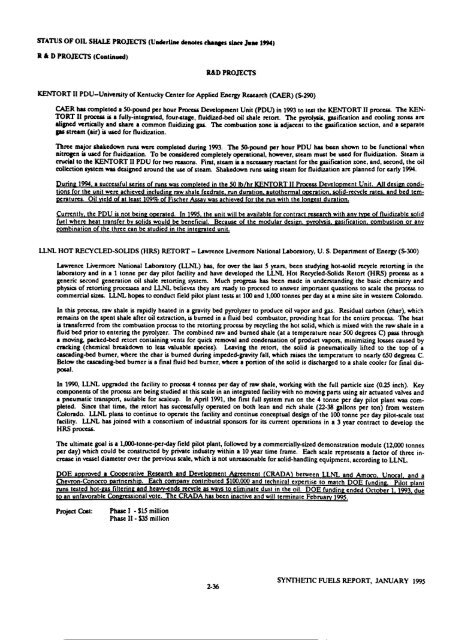Ikelic - Alliance Digital Repository
Ikelic - Alliance Digital Repository
Ikelic - Alliance Digital Repository
Create successful ePaper yourself
Turn your PDF publications into a flip-book with our unique Google optimized e-Paper software.
STATUS OF OIL SHALE PROJECTS (Underline denotes changes sine* June 1994)<br />
R&D PROJECTS (Continued)<br />
R&D PROJECTS<br />
KENTORT II PDU-University of Kentucky Center for Applied Energy Research (CAER) (S-290)<br />
CAER has completed a 50-pound per hour Process Development Unit (PDU) in 1993 to test the KENTORT II process. The KEN<br />
TORT II process is a fully-integrated, four-stage, fluidized-bed oil shale retort. The pyrolysis, gasification and zones are<br />
cooling<br />
aligned vertically and share a common fluidizing gas. The combustion zone is adjacent to the gasification section, and a separate<br />
gas stream (air) is used for fluidization.<br />
Three major shakedown runs were completed during 1993. The 50-pound per hour PDU has been shown to be functional when<br />
nitrogen is used for fluidization. To be considered completely operational, however, steam must be used for fluidization. Steam is<br />
crucial to the KENTORT II PDU for two reasons. First, steam is a necessary reactant for the gasification zone, and, second, the oil<br />
collection system was designed around the use of steam. Shakedown runs using steam for fluidization are planned for early 1994.<br />
During 1994. a successful series of runs was completed in the 50 Ib/hr KENTORT II Process Development Unit. All design condi<br />
tions for the unit were achieved including raw shale feedrate. run duration, autothermal operation, solid-recycle rates, and bed tem<br />
peratures. Oil yield of at least 109% of Fischer Assay was achieved for the run with the longest duration.<br />
Currently, the PDU is not being operated. In 1995. the unit will be available for contract research with any type of fluidizable solid<br />
fuel where heat transfer bv solids would be beneficial. Because of the modular design, pyrolysis. gasification, combustion or any<br />
combination of the three can be studied in the integrated unit.<br />
LLNL HOT RECYCLED-SOLIDS (HRS) RETORT - Lawrence Livermore National Laboratory, U. S. Department of Energy (S-300)<br />
Lawrence Livermore National Laboratory (LLNL) has, for over the last 5 years, been studying hot-solid recycle retorting in the<br />
laboratory and in a 1 tonne per day pilot facility and have developed the LLNL Hot Recycled-Solids Retort (HRS) process as a<br />
generic second generation oil shale retorting system. Much progress has been made in understanding the basic chemistry and<br />
physics of retorting processes and LLNL believes they are ready to proceed to answer important questions to scale the process to<br />
commercial sizes. LLNL hopes to conduct field pilot plant tests at 100 and 1,000 tonnes per day at a mine site in western Colorado.<br />
In this process, raw shale is rapidly heated in a gravity bed pyrolyzer to produce oil vapor and gas. Residual carbon (char), which<br />
remains on the spent shale after oil extraction, is burned in a fluid bed combustor, providing heat for the entire process. The heat<br />
is transferred from the combustion process to the retorting process by recycling the hot solid, which is mixed with the raw shale in a<br />
fluid bed prior to entering the pyrolyzer. The combined raw and burned shale (at a temperature near 500 degrees C) pass through<br />
a moving, packed-bed retort containing vents for quick removal and condensation of product vapors, minimizing losses caused by<br />
cracking (chemical breakdown to less valuable species). Leaving the retort, the solid is pneumatically lifted to the top of a<br />
cascading-bed burner, where the char is burned during impeded-gravity fall, which raises the temperature to nearly 650 degrees C.<br />
Below the cascading-bed burner is a final fluid bed burner, where a portion of the solid is discharged to a shale cooler for final dis<br />
posal.<br />
In 1990, LLNL upgraded the facility to process 4 tonnes per day of raw shale, working with the full particle size (0.25 inch). Key<br />
components of the process are being studied at this scale in an integrated facility with no moving parts using air actuated valves and<br />
a pneumatic transport, suitable for scaleup. In April 1991, the first full system run on the 4 tonne per day pilot plant was com<br />
pleted. Since that time, the retort has successfully operated on both lean and rich shale (22-38 gallons per ton) from western<br />
Colorado. LLNL plans to continue to operate the facility and continue conceptual design of the 100 tonne per day pilot-scale test<br />
facility. LLNL has joined with a consortium of industrial sponsors for its current operations in a 3 year contract to develop the<br />
HRS process.<br />
The ultimate goal is a 1,000-tonne-per-day field pilot plant, followed by a commercially-sized demonstration module (12,000 tonnes<br />
per day) which could be constructed by private industry within a 10 year time frame. Each scale represents a factor of three in<br />
crease in vessel diameter over the previous scale, which is not unreasonable for solid-handling equipment, according to LLNL.<br />
DOE approved a Cooperative Research and Development Agreement (CRADA^ between LLNL and Amoco. Unocal, and a<br />
Chevron-Conocco partnership. Each company contributed $100,000 and technical expertise to match DOE funding. Pilot plant<br />
runs tested hot-gas filtering and heavy-ends recycle as ways to eliminate dust in the oil. DOE funding ended October 1. 1993. due<br />
to an unfavorable Congressional vote. The CRADA has been inactive and will terminate February 1995.<br />
Project Cost: - Phase I $15 million<br />
Phase II $35 million<br />
2-36<br />
SYNTHETIC FUELS REPORT, JANUARY 1995















![pace SrntfletIc fne]its report - Alliance Digital Repository](https://img.yumpu.com/10493335/1/190x245/pace-srntfletic-fneits-report-alliance-digital-repository.jpg?quality=85)
